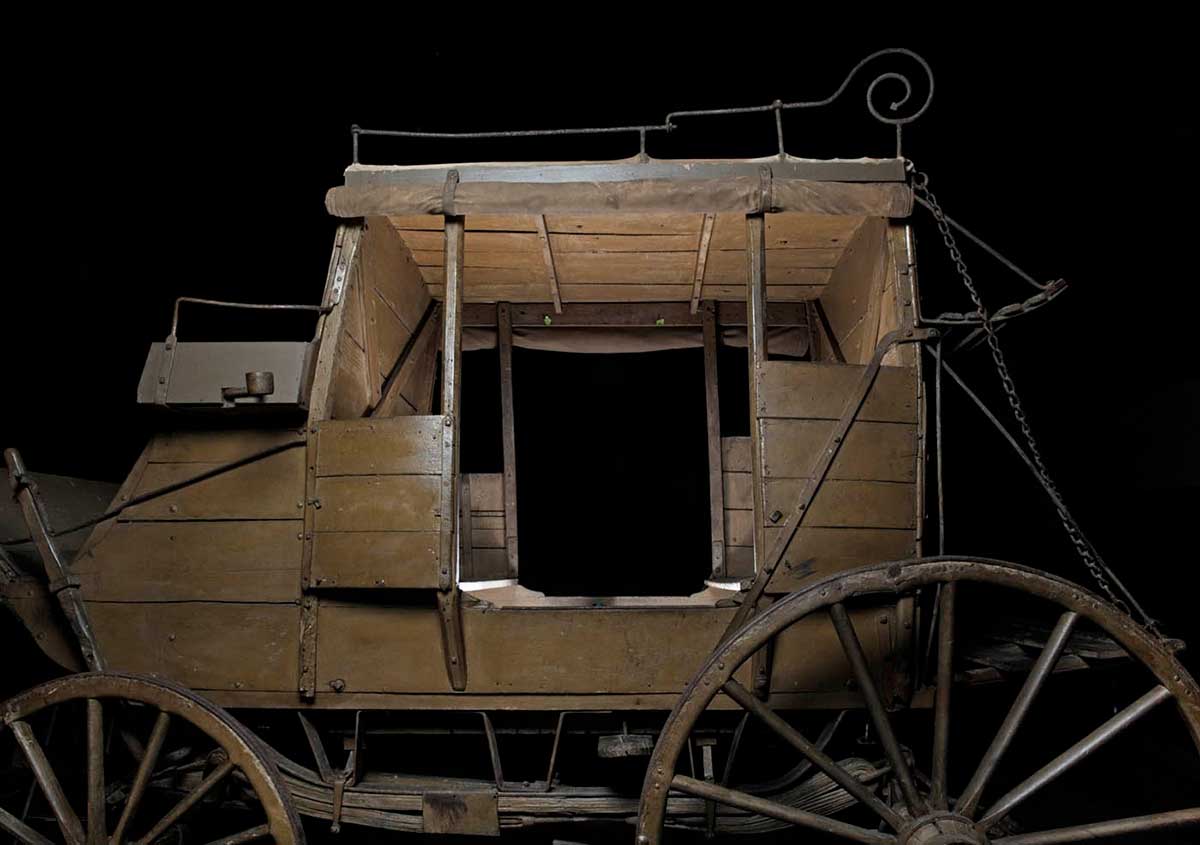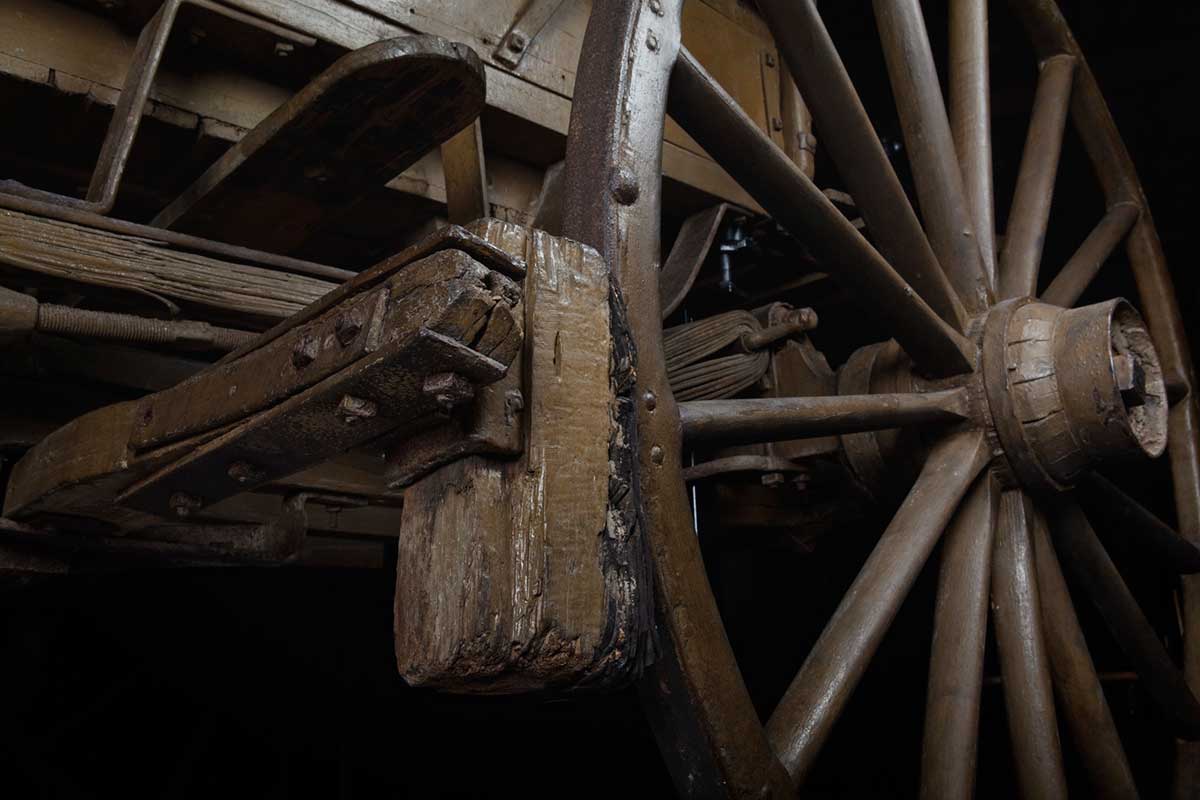Coaches played an important part in Australia's transport and communication history. This Concord model thorough-brace coach was used to transport mail and passengers in northern New South Wales.
The coach was originally owned by the Nowland family and used on their network of mail and passenger services in the Liverpool Plains area, probably from the 1870s until 1919.
It also featured in the 1920 Australian silent film The Man from Kangaroo and the 1957 production of Robbery Under Arms.
Concord throrough-brace coach
Thorough-brace technology is a significant example of a particular type of horse-era technology. This model was developed in Concord, New Hampshire, in the United States.
Earlier, coach suspension consisted of steel springs. Though suitable for paved and cobbled roads in England, the rougher conditions of the American west demanded a different system as coaches with steel spring suspension jolted violently on ruts and bumps, and the springs often broke.
Thorough-brace suspension used thick leather straps that more effectively cushioned its passengers, although its swaying and rolling motion could cause motion sickness, and many passengers preferred the box seat beside the driver.
Cobb & Co
This flexible suspension had the further benefit of reducing weight on the wheels and strain on the horses, an important factor for travelling the vast distances of the frontier. Australian road conditions were similar to those in the American west and the Cobb & Co coach company realised the potential of the Concord in the local market.
Cobb & Co released its first Concord in Australia in 1854. The Nowland's coach may have been made by Cobb & Co or one of the many coachworks in Australia in the 19th century.
The thorough-brace technology made it ideal for transporting mail in the Australian outback. It was designed to deal with unsealed dirt roads, with potholes and ruts, which were typical in northern New South Wales in the 1880s.
A top speed of 15 miles an hour ensured fast delivery of the mail in an era before telegraphic technology.
Liverpool Plains
From the late 1820s, settlers flooded into the Liverpool Plains on the inland slopes north-west of Sydney. An extensive coach network was developed to link inland towns.
Pastoralist Robert Nowland secured the mail contract for the Gunnedah-to-Walgett run. By 1874 Nowland's Line of Coaches was carrying many of the 40 mail deliveries that arrived each week at Gunnedah.
Bushrangers
In 1863 one of the Nowland's mail coaches was held up between Murrundi and Willow Tree. Bushrangers robbed the passengers and slashed the mail bags, but somehow managed to miss a bag of gold stowed in the back.
Bushranging had signficantly declined in New South Wales by the 1880s though a mail coach was held up in Australia as late as 1910.
The Man from Kangaroo
The Man from Kangaroo was filmed near Gunnedah and further south in Kangaroo Valley.
The film stars Reginald 'Snowy' Baker, an Australian all-round sportsman, who remains the only person to represent Australia in three separate sports at the Olympics. Baker was also interested in developing the Australian film industry and he co-founded Carroll-Baker Australian Productions to realise this dream.
The Man from Kangaroo features Baker in the role of John Harland, a boxing parson whose romantic interest, Muriel Hammond, is played by American film star Brownie Vernon.
Baker's athletic abilities were put to good use through spectacular stunts, all of which he performed himself. He is seen diving into a rock pool, boxing villains and riding his horse at breakneck speeds along dusty bush tracks in pursuit of cattle thieves.
The film also features a coach stunt on Hampden Bridge, a heritage-listed suspension bridge on the Moss Vale road, which is still in use in Kangaroo Valley today.
Vernon has been abducted by cattle-rustlers and taken away in the coach. Baker follows in hot pursuit, gaining on the villains and executing a death-defying leap onto the coach in mid-gallop. He defeats the kidnappers, and to make good their escape, Baker and Vernon leap from the roof of the coach as it moves over Hampden Bridge, plunging into the Shoalhaven River below.
Robbery Under Arms
Following the making of The Man from Kangaroo the producers donated the coach to the Royal Australian Historical Society in Sydney. There, it was put on permanent display in the 'Museum of Australian Historic Objects' at Vaucluse House.
Though coaches were fast being superseded by the motor car, the last of the Cobb & Co passenger coaches was not retired until three years after this donation in 1924.
In 1957 the coach featured in the Rank Organisation's production of Robbery Under Arms. The film was shot around Bourke in New South Wales and Wilpena Pound in South Australia. The coach was transported by road in a special trailer from Vaucluse House to Port Augusta.
In Robbery Under Arms the coach features in a hold-up scene. It is first glimpsed barrelling down an inland highway before being bailed up by the fictional bushranger Captain Starlight and his gang.
Starlight was played by renowned Australian actor Peter Finch. In Finch's portrayal of the debonair Starlight, the coach's interior is seen from different angles as Starlight flirts with the two female passengers.
Caring for the coach
The Nowland's mail coach was acquired by the National Museum of Australia in 1980. It was purchased from the Royal Australian Historical Society with another coach, a wooden horse-drawn landau known as the Ranken coach.
The Nowland's coach came into the collection painted khaki, which is not original. The manufacturer's plate and any other insignia had been painted over but curatorial research and conservation work revealed more of the coach's history, despite the lack of visual clues.
In our collection

